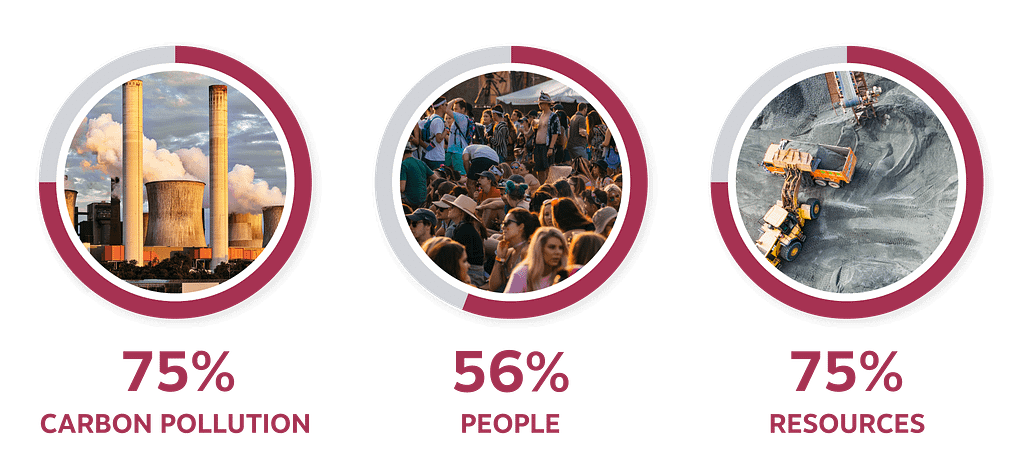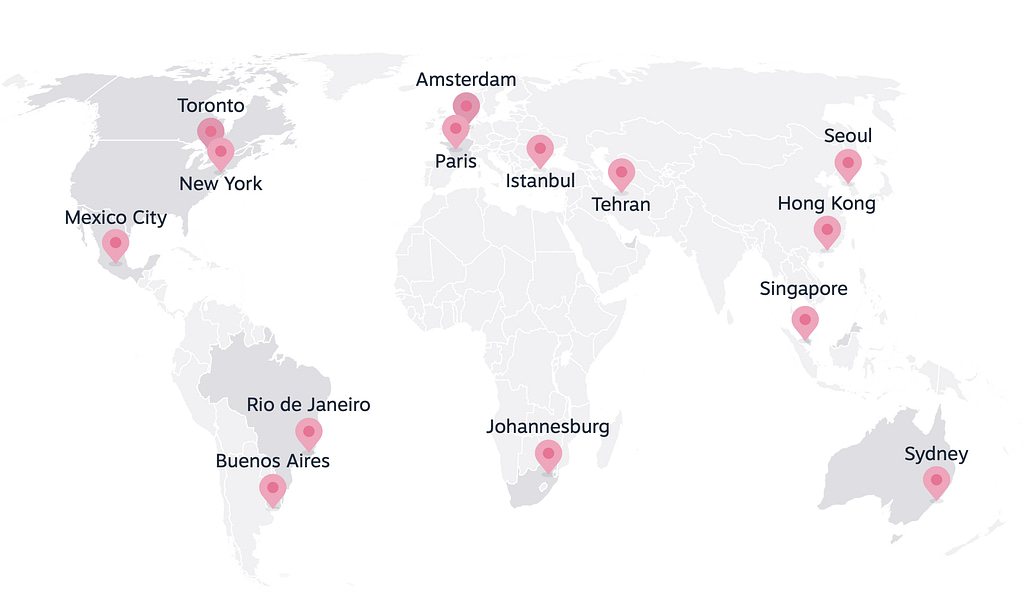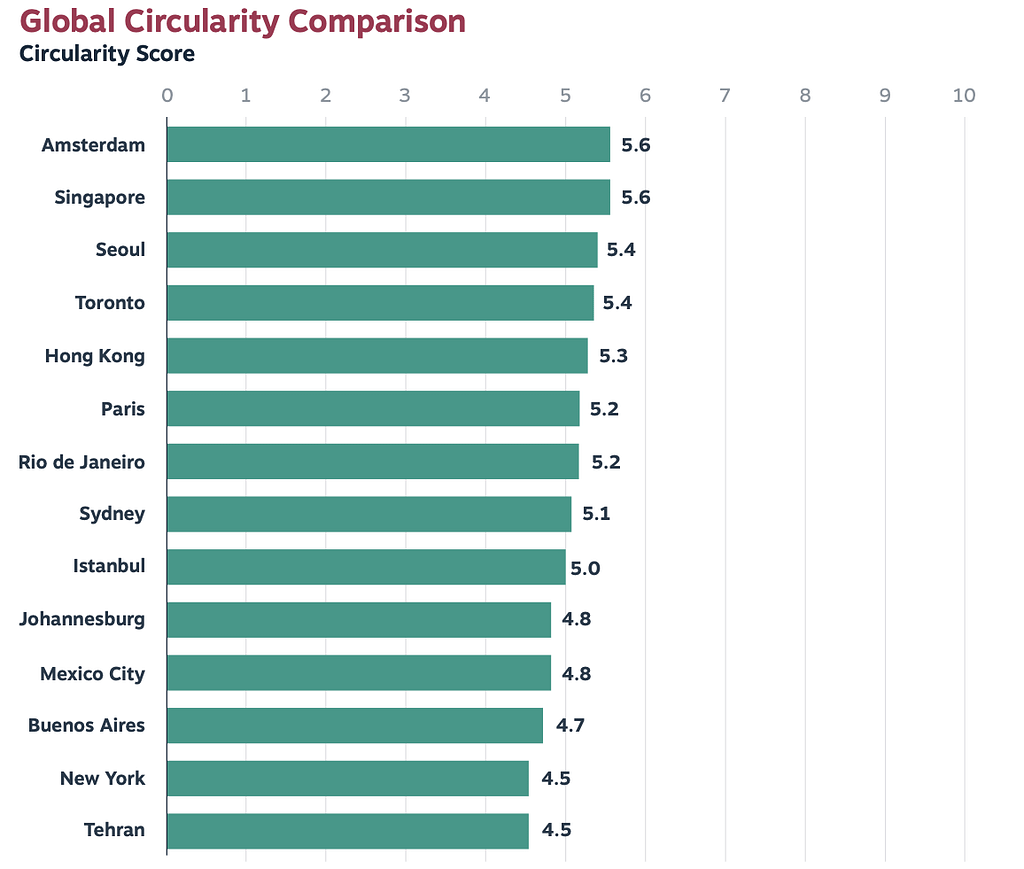Drawing on our deep systems thinking expertise and 12 years of city collaborations, we developed the Circular Urban Scan: a holistic benchmarking tool evaluating and monitoring the sustainability of cities. An automated scan that accelerates the transition based on systems thinking by scanning seven perspectives: materials, energy, water, biodiversity, culture, well-being and economic value.
Cities on a journey to reinvent themselves
Cities want to become healthy, sustainable, and inclusive places. They wish to foster strong communities and allow all species to flourish, while remaining within the limits of the planet. At Metabolic we have been working with over 200 such cities since 2012. We have seen first hand effective assessments, plans, and implementation strategies transform cities into sustainable, efficient, and urban environments.
There is work to do, because today cities are still the largest driver of environmental impact – globally. They account for 75% (United Nations) of the world’s total carbon emissions, host 56% of the global population (The World Bank), and consume 75% of the world’s primary energy (United Nations). The United Nations projects that 70% of the world’s population will reside in urban areas by 2050, so these numbers will only increase.
If humans aim to live healthily and raise children in cities, it is clear that the direct and indirect impacts they have need to be aligned with what our planet can support. A paradigm shift is essential to reimagine cities that face a multitude of economic, social, and environmental challenges, from climate change to economic stagnation.

Systems thinking is our trademark
Finding genuinely sustainable solutions requires a deep understanding of how different parts of a system fit together. In cities, many complex elements interact dynamically, influencing each other and the system as a whole. By adopting our trademark systems thinking approach, we can uncover the interdependencies and develop integrated solutions that address multiple issues simultaneously. This breaks free from ‘siloed thinking’ and fosters a more comprehensive understanding of urban dynamics, ultimately paving the way for transformative change toward sustainable and resilient cities. This approach is at the heart of the Circular Urban Scan (CUS).
Applying circular principles into a city scan
Defining the key city challenges
Metabolic’s Circular Urban Scan applies our foundational systems thinking model: the 7 Pillars of the Circular Economy to the urban environment. The CUS focuses on relationships between 7 key elements, called ‘pillars’: Materials, Energy, Water, Biodiversity, Society & Culture, Health & Well-being, and Value. It uses two metrics for each pillar designed to be accessible for every city, based upon open source data. Cities are scored from 0 to 10 for each metric. This provides an initial comprehensive overview of their circular economy status, identifies opportunities, and allows for ongoing assessment of initiatives’ impact over time.
The 7 pillars as a method for cities
To understand our holistic approach, we need to describe the 7 pillars and why they are key to evaluating the sustainability performance of a city. For each aspect we explain the metrics used by the Circular Urban Scan.

- Materials: Sustainable cities aim to preserve the value of materials and keep them cycling at their highest value for as long as possible. Achieving this means using virgin materials only when absolutely necessary, and always implementing “higher R” strategies (i.e. rethink, reduce, reuse, repair, refurbish, and remanufacture) that are more effective at preserving material value than “lower R” strategies (i.e., recycle and recover).
- Energy: A key element and central to almost all economic activities, even if its generation is usually outside of the city boundaries, it is often related to adverse environmental impacts (e.g. greenhouse gas emissions) and the use of devices made of scarce materials (e.g. lithium in batteries). The circular economy aims to minimize the environmental impact of energy generation and create energy systems that utilize renewable and sustainable energy supply.
- Water: Water is essential to any economy and more importantly human life, but again most of the extraction occurs outside of the city limits. Therefore the sustainable use of water resources is a crucial part of a circular economy in which the value of water is maintained and indefinitely re-used. Sustainable water management implies protected watersheds and harmful emissions to aquatic systems are avoided.
- Biodiversity: Nature is full of interdependencies, not only between humans and animals but between myriad forms of life intimately connected. Biodiversity is a key component in preserving complex natural ecosystems within cities but also outside them. If diminished, these systems quickly fall out of balance, having significant impacts on the economy and human well being.
A circular economy preserves biodiversity by protecting habitats and promoting ecological diversity to establish a resilient biosphere. - Society & Culture: Human culture and social cohesion are important factors to preserve in order, to maintain and further cultivate a prosperous city. From a circular economy lens, this reflects an effective relationship between stakeholders and economic actors, including their models, processes, and organizations.
- Health & Wellbeing: The Circular Economy should promote healthy and balanced societies within cities. Thus economic activities that harm or threaten human well-being and health should be excluded. At the same time, toxic and hazardous elements must be kept to a minimum and in rigorously controlled cycles, aiming for their ultimate elimination.
- Value: An economy is the representation of the resources available in a system. These resources should be fairly distributed ensuring that they create the maximum positive impact in society. In a circular economy, this means that resources must be used to maximize value creation across multiple categories besides financial (e.g., aesthetic, emotional, ecological).
Now that we have explained the method, let’s look at how the CUS is applied.
Why conduct a Circular Urban Scan?
In line with Paris Agreement and methodologies such as science-based targets
The CUS aligns with global sustainability goals, such as those set by the Paris Agreement, helping cities to navigate the complexities of urban sustainability and drive transformative change. By leveraging an open-source data methodology, the CUS enables a comprehensive assessment of urban sustainability practices, offering cities a transparent, collaborative platform for benchmarking their efforts. This not only fosters comparability but also encourages the adoption of best practices through a scoring system designed to reflect realistic achievements and potential areas for improvement. It provides cities with tailored recommendations on data measurement and collection, laying the groundwork for a robust, reliable monitoring system. By offering a step-by-step guide to improvement, the Circular Urban Scan makes it easier for cities to plan their journey towards being more circular and resource-smart, ensuring that their efforts lead to real, impactful changes.
Circular Urban Scan of 14 cities
To introduce the Circular Urban Scan, we share insights from 14 global cities that were scanned. The selected cities are: Amsterdam, Singapore, Seoul, Toronto, Hong Kong, Paris, Rio de Janeiro, Sydney, Johannesburg, Mexico City, Buenos Aires, Istanbul, Teheran and New York City. This selection is based on multiple criteria related to location, economics and size.

Some overarching key insights:
- There is still much to be done: Even leading cities are still far from achieving full sustainability or circularity. For instance, Amsterdam, the top-scoring city, only rates 5.9 out of 10 on the Circularity Urban Scan, falling within the ‘normal’ range. While this indicates substantial room for improvement, it also highlights significant potential for growth. Amsterdam’s score signifies moderate progress across sustainability metrics, with notable areas for enhancement in waste management and resource conservation.
- Money is not paramount: The economic development alone does not determine a city’s circular performance, New York for example, may be the economic capital of the world, yet it has strides to make in sustainability and circularity. Despite its economic prowess, New York faces challenges in waste reduction and energy consumption, indicating a need for targeted interventions to align economic growth with sustainability goals.
- Leadership cities demonstrate achievable sustainability results: The presence of dedicated teams and policies focused on sustainability emerges as a key driver of positive outcomes. Singapore, for instance, moved towards circularity early due to its unique geographic conditions and resource constraints. Singapore’s proactive approach to sustainability, driven by government initiatives and public-private partnerships, sets a precedent for other cities seeking to accelerate their transition to circular economies.
- Patterns in gaps signal opportunities for targeted interventions in specific sectors: Our current economic system often prioritizes investments that yield immediate benefits to human experiences, such as social life and financial impact, over those that promote ecological balance (energy, water, and biodiversity). This imbalance underscores the importance of a holistic approach that integrates human-centric needs with environmental sustainability, a role in which the Circularity Urban Scan (CUS) can play a vital part. Cities can address these gaps by implementing targeted interventions, such as incentivizing renewable energy adoption, implementing water conservation measures, and preserving biodiversity through urban green spaces and conservation initiatives.
- Call to action for cities to embrace circular economy principles: Material consumption and waste generation tend to increase with economic development (World Bank), challenging the perception that wealth equates to sustainability. It’s imperative for cities, particularly those in development, to learn from past mistakes and forge pathways to a sustainable future. By embracing circular economy principles, cities can optimize resource use, minimize waste generation, and promote sustainable consumption and production patterns. This requires a paradigm shift towards circularity in urban planning, infrastructure development, and policy-making processes. challenging the perception that wealth equates to sustainability. It’s imperative for cities, particularly those in development, to learn from past mistakes and forge pathways to a sustainable future.
- Energizing our sustainable futures is a priority: In the energy sector, cities lacking direct access to fossil fuels but endowed with alternative natural resources, like sun or water, often fare better, good examples are Casablanca or Rio de Janeiro. The overall low energy sustainability scores highlight the importance of prioritizing energy efficiency, renewable energy adoption, and innovation in addressing the diverse energy challenges faced by cities. By learning from leading cities, addressing energy management gaps, and fostering collaboration, cities can advance their energy transition agendas and contribute to a more sustainable and resilient urban future.


Circular Urban Scan results in improvement of data collection
The outcome of the scan is to highlight risk areas and identify leverage points. The Circular Urban Scan creates a baseline around sustainability and data collection to develop a strategy around it. After this year 0 measurement, we can evaluate how efficient each city’s strategy is on a yearly basis and how to improve the data collection for better understanding of the circular state. The CUS is used to monitor results year by year, allowing city planners and policymakers to adjust, correct, or eliminate tactics.
Circular Urban Scan stepping stone to deeper understanding
After assessing the CUS results, at Metabolic, we develop a holistic strategy based on Systems Thinking to improve a city’s performance focusing either on the metrics and pillars with low-hanging fruit or in the areas where improvement is most impactful. To deepen the understanding of a city we focus on:
Defining a baseline of the materials, energy and water used, thanks to a Flow Analysis Read here how a Material Flow Analysis helped the city of Charlotte to create its first Innovation hub.
Mapping the resources and areas of interest for a specific sector or metric, using geospatial information (GIS). Read here how a geospatial analysis is helping Poland to connect circular demand and supply of materials.
Co-creating a holistic strategy with citizens and key stakeholders from public and private environments. Read here how a co-created strategy is transforming the industrial sector in Portland with the leadership of public, private and academic sectors.
Defining KPIs and a plan to monitor the city’s performance and evaluate the impacts of the deployed strategies. Read here how Rotterdam set their KPIs around circularity to become one of the most circular cities in the world.
Training and supporting capacity building and change management so that the knowledge we bring to the table stays in the entities involved and supports independent work. Read here how living labs have helped Amsterdam to increase awareness around our impacts and the possible sustainable approaches to city development.
In essence, the Circular Urban Scan is not just a diagnostic tool; it’s a catalyst for transformative change. As we navigate the complexities of urban sustainability, these insights and follow-up services become guiding beacons, illuminating the path toward a circular and resilient urban future.
To find out more about getting the full picture of your city’s circular state, register your interest in a Circular Urban Scan here, or reach out directly to Director of Sustainable Cities & Regions Gerard Roemers – [email protected]




